

Union of South Africa
Unie van Zuid Afrika
Grant of 1911 / Red Ensign and other flags / 1930 drawing
1932 drawing (and South African independence) / Republic of South Africa, 1961
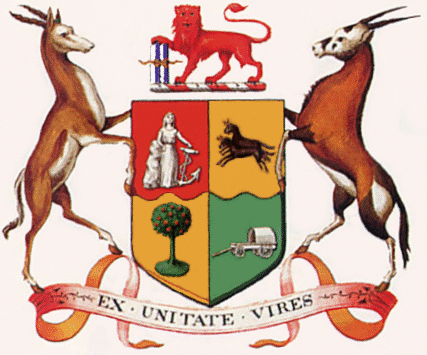
Arms granted by the College of Arms in London (the grant described as being by Royal Warrant) on 17 September 1910. The official blazon reads:
Quarterly per fesse wavy First Quarter Gules a female figure representing Hope resting the dexter arm upon a rock and supporting with the sinister hand an Anchor Argent Second Quarter Or two Wildebeesten in full course at random both proper Third Quarter Or upon an Island an Orange tree Vert fructed proper Fourth Quarter Vert a Trek Waggon Argent And for the Crest On a Wreath of the Colours A Lion passant gardant Gules supporting with the dexter paw four staves erect alternately Argent and Azure and banded Or And for the Supporters, On the dexter side A Spring Buck and on the sinister side An Oryx (Gemsbuck) both proper together with the Motto EX UNITATE VIRES.
Explanation:
The four quarters represent the four provinces making up the Union, and the wavy horizontal line of partition represents the Orange River (called Gariep by the Khoikhoi people, who occupied this river’s valley prior to the arrival of either black or white settlers).
The first quarter contains the symbolic figure of Hope which formed the crest of the Cape of Good Hope Colony’s (Cape Colony’s) arms; the second quarter has the black wildebeest of the arms of Natal; the third quarter the orange tree of the Oranje Vrij Staat (see that republic for a discussion on the kind of tree intended); and the fourth quarter the wagon from the base of the Zuid Afrikaansche Republiek’s arms (although the half-tented wagon shown is in fact a transport wagon, as in the seal of the Transvaal Colony, not a trek wagon or kakebeenwa).
The lion in the crest recalls lions in the arms of England, of Scotland (see Great Britain), and of the Principality of Wales (see the arms of Prince Charles), as well as the Kingdom of the Netherlands and several of the Dutch provinces. Its colouring is that of the lion of Scotland, while its stance is that of the lion in the English crest. The natural lion (Leo leo) is also indigenous to South Africa.
The four staves (one for each province) recall the classical tale of a Roman father who invited his sons to break twigs, and then bound a bundle of them to prove that, just as bound sticks were unbreakable, so they would be strong when they stood together. They also recall the seven bound arrows held by the lion in the Dutch royal arms, symbolising the seven provinces of the kingdom.
The dexter supporter, a springbok (Antidorcas marsupialis), was taken from the arms of the Orange River Colony, and had been regarded as a national symbol since the 1906 rugby tour of Britain by a team representing the four colonies, captained by Paul Roos. The team was dubbed the Springboks, and used green jerseys (a set of jerseys from Cape Town’s Old Diocesan Club had been packed by one of the team members). To this day the national rugby team is called the Springboks and wears green jerseys.
The sinister supporter is a gemsbok (the Afrikaans spelling is now favoured in South African English) or oryx (Oryx gazella gazella), which had been a supporter of the arms of the Cape Colony. The other supporter in the Cape arms was a wildebeest; this animal came into the Union arms in the Natal quarter, and so was not considered as a supporter for the Union.
The motto translates as “Out of Unity, Strength”, and is a translation into Latin of the ZAR’s motto, “Eendragt maakt Magt”.
Although the principal colours of the shield as a whole are red, gold and green, the crest-wreath takes its colours from the first (Cape) quarter.
Background:
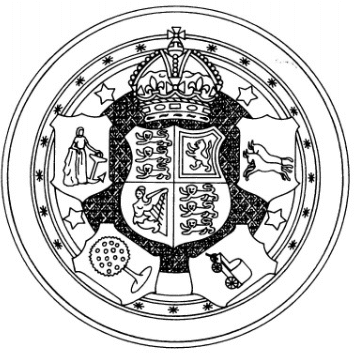 The need for a coat of arms was determined by the fact that the Union of South Africa, which came into being on 31 May 1910, was a constitutional monarchy (see below), so requiring a Great Seal. State Herald F G Brownell calls this device the supreme emblem of sovereignty, the clavis regni, the only instrument by which on solemn occasions the will of the sovereign can be expressed.
The need for a coat of arms was determined by the fact that the Union of South Africa, which came into being on 31 May 1910, was a constitutional monarchy (see below), so requiring a Great Seal. State Herald F G Brownell calls this device the supreme emblem of sovereignty, the clavis regni, the only instrument by which on solemn occasions the will of the sovereign can be expressed.
However, when the first Great Seal was made (at considerable expense) at the Royal Mint in London, it was found that it conflicted with the Royal Warrant in that the arms in its centre were not the quartered Union arms, but the arms of the British monarch,[1] with separate shields representing the four provinces around the edge of the seal.
Since the quarters representing the provinces had been granted as a single coat of arms, and not as separate shields, it was then arranged for a further Royal Warrant to be issued. Dated 4 May 1911, it granted the four quarters as separate coats of arms respectively to the four provinces: a red shield bearing the lady Hope for the Cape, a gold shield with two wildebeeste for Natal, a gold shield with an orange tree for the Orange Free State, and a green shield with an oxwagon for the Transvaal.
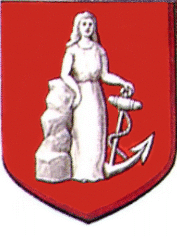
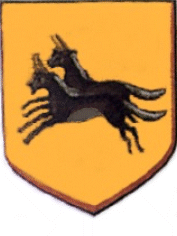
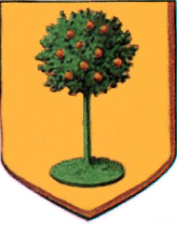
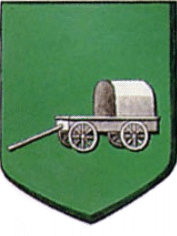
However, when the warrant arrived in Pretoria the Prime Minister’s office reported to London that the arms as granted to the provinces were not acceptable to them. The warrant was not communicated to the provinces, and they carried on using the arms borne previously.
Languages of the Union:
The Union’s official languages were English and Dutch. The status of the official languages was entrenched in the Constitution: the language clause could not be altered except by a two-thirds majority of both Houses of Parliament in joint session.
Flags of the Union:
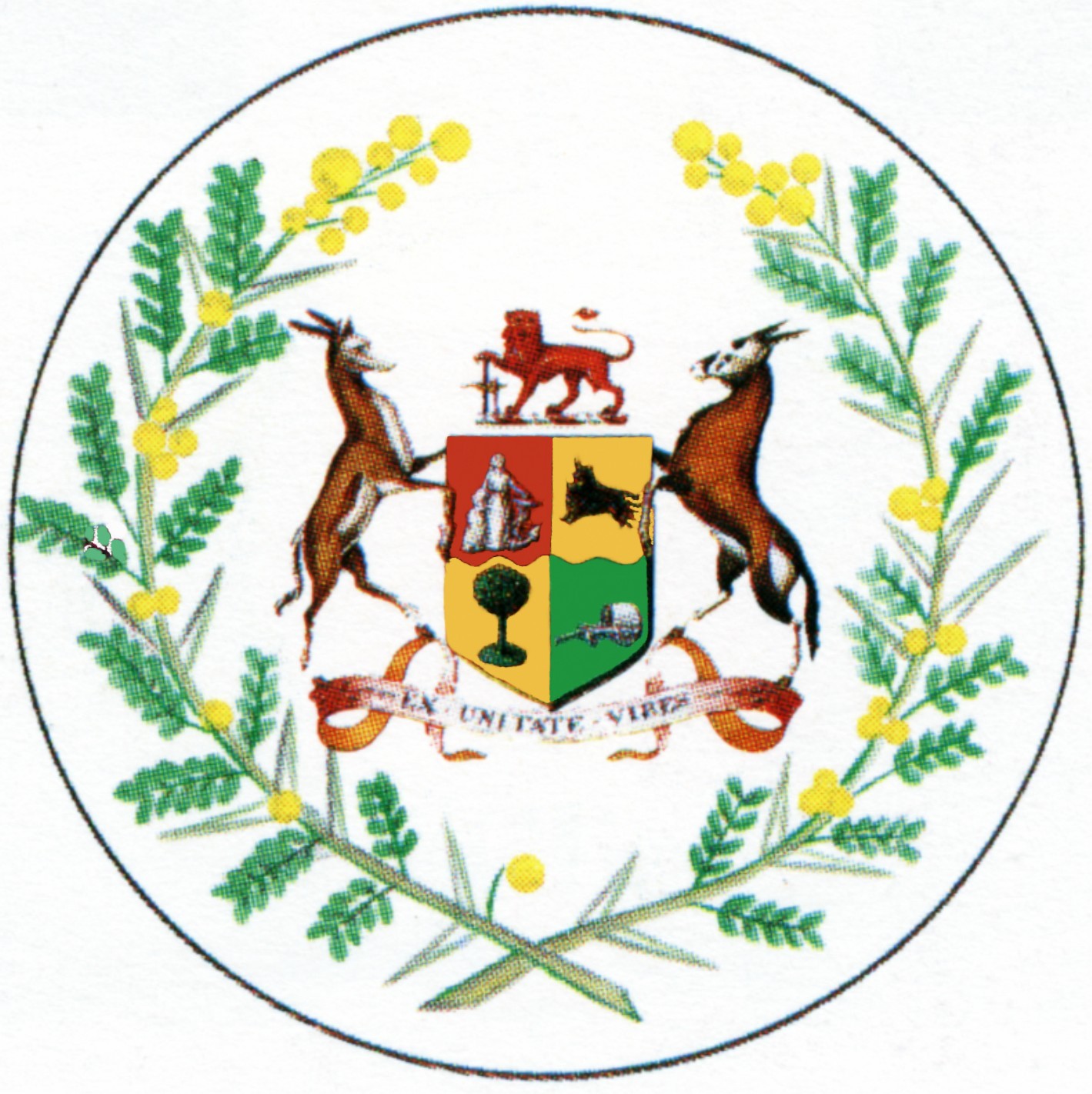
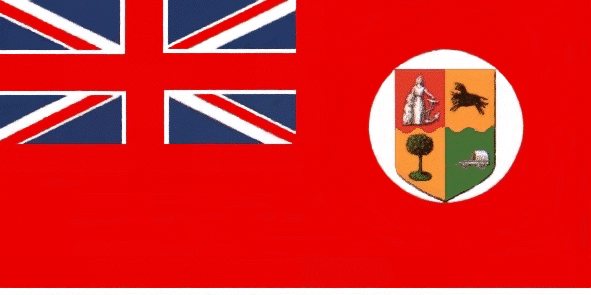 As was the case with other British possessions, the Union’s principal flag was initially the (British) Union Jack, augmented by a suite of flags derived from it which had South African symbols added.
As was the case with other British possessions, the Union’s principal flag was initially the (British) Union Jack, augmented by a suite of flags derived from it which had South African symbols added.
The Governor-General’s flag was a Union Jack with the Union of South Africa’s coat of arms wreathed in flowering mimosa branches on a white roundel at the centre. The Prime Minister, General Louis Botha, favoured the mimosa as South Africa’s national tree. (The term mimosa is no longer used for trees of the genus Acacia, whether indigenous to South Africa or Australian. It is not clear which of the indigenous species is intended, but it is quite likely Acacia karoo.) However, this flag was only for use at sea.
The flag of the Government, on land and at sea, was a Blue Ensign with the shield of the Union arms in the fly, and the merchant flag a Red Ensign also with a Union shield in the fly. The first version of the Red Ensign had the shield on the red background with no contrasting highlight, but in 1912 this was changed when the shield was placed on a white roundel (as shown here). The Blue Ensign, however, continued in its original form, without a white roundel.
Capitals of the Union:
The delegates to the National Convention could not agree on a single capital for the Union, so a compromise was reached whereby Pretoria became the administrative capital, Cape Town the legislative (using the buildings of the Cape Colony’s Parliament) and Bloemfontein the judicial capital.
In the early years of Union the Union Buildings were erected on Meintjes Kop, Pretoria, to serve as the administrative “palace”, and a large courthouse was erected in Bloemfontein as the seat of the Appellate Division of the Supreme Court of South Africa.
The Pretoria/Cape Town split meant that the Governor-General, the Prime Minister, the Cabinet and the top echelons of the administration had to move to Cape Town for the duration of the parliamentary session each year. At the time of writing in 2001 this is still the way South Africa is run, although aircraft and rapid road transport are now preferred for transporting the President and his Ministers and officials, to the trains that were formerly used for the move.
Constitutional development:
The Union was formed on 31 May 1910 as a parliamentary union of the four self-governing British colonies south of the Limpopo River, now become provinces of the Union: the Cape of Good Hope Province (Cape Province; previously Cape Colony), the Natal Province (Natal Colony), the Orange Free State Province (Oranje Vrij Staat/Orange River Colony) and the Transvaal Province (Zuid Afrikaansche Republiek/Transvaal Colony).
The new state was formally called a British Dominion, and its Head of State was the British sovereign (at the time of Union, the newly acceded King George V), represented in South Africa by a Governor-General, appointed on the advice of the British Cabinet. Parliament comprised the Governor-General and two Houses: the House of Assembly and the Senate. The Head of Government was a Prime Minister appointed by the Governor-General and having the support of the majority in the Assembly.
The King’s title, as far as South Africa was concerned, had been laid down by the Royal Titles Act, passed by the Westminster Parliament in 1901. It declared King Edward VII to be King “of the British Dominions beyond the Seas”. At that stage the term “Dominions” covered all the British possessions, but in 1907, at the very first quadrennial Imperial Conference, the status of the self-governing Dominions was discussed.
The Governor-General was simultaneously appointed British High Commissioner for Southern Africa, directly responsible for the administration of the three British protectorates (also known as the High Commission territories) of Basutoland, Bechuanaland and Swaziland. There was an understanding that these territories, and perhaps also Rhodesia to the north, would eventually become part of the Union.
The Post Office of the Union provided postal services (using South African postage stamps) in Basutoland and Swaziland, but not in Bechuanaland. Although South Africa issued one postage stamp on Union Day (31 May 1910), it did not issue a definitive postage series until 1913, and during its first three years used stamps of all four colonies, which were valid for use throughout the Union and in Basutoland and Swaziland.
A major flaw in the Union’s Constitution lay in the franchise. At the National Convention in 1909 the Cape delegates tried to convince the other three colonies of the wisdom of extending the vote beyond white men (only white men had the vote in the Orange River Colony and Transvaal, while Natal’s restrictions on non-white voters meant that virtually none qualified). The Cape franchise, based on property, meant that large numbers of Coloured and black men shared the vote with white men. But the other colonies disagreed, and only in the Cape was a colour-blind franchise accepted for the Union. This was to lead to serious complications.
The Union was not independent, as was demonstrated in 1914 when Britain’s declaration of war against Germany and Austria automatically put South Africa at war with its neighbour, German South West Africa.
The role played by the Dominions in the First World War soon convinced Britain that their status needed to be raised. South Africa, although it first had to suppress a rebellion by commando members, quickly took control in German South West, occupying it until 1919, when the League of Nations granted it a C Mandate. This allowed South Africa to treat South West Africa as a province. South African forces next (in 1916) joined the war against German East Africa, where Boer War commando leader Jan Christian Smuts (a Cabinet Minister) was appointed General Officer Commanding British Forces. Smuts was later co-opted with other Dominion Ministers into the Imperial War Cabinet, where he made a valuable contribution. Smuts and Prime Minister Louis Botha played a significant role at the peace talks at Versailles, where Smuts contributed to the formation of the League of Nations and succeeded as Prime Minister when Botha died suddenly.
Smuts continued to play a part in international affairs at the 1921 Empire Conference, and although he was replaced as Prime Minister by General J B M Hertzog in the 1924 general election, it was Smuts’s ideas that were put forward at subsequent Empire Conferences and led to the formation of the Commonwealth of Nations, comprising Britain and the Dominions.
South Africans, like other subjects of the British Crown, were recipients of royal honours in the form of knighthoods, baronetcies and lesser awards, and in a single instance a barony. However in 1925 Parliament, on a motion by Arthur Barlow MP (Labour), resolved that no South African would in future accept any British title. Since the British sovereign (then still George V) was South Africa’s Head of State, this was a direct affront to the King. It was, however, accepted in London on the principle that the King accepted the advice of his Ministers, whether in Britain or in the self-governing dominions and colonies.
Union of South Africa
Unie van Suidafrika
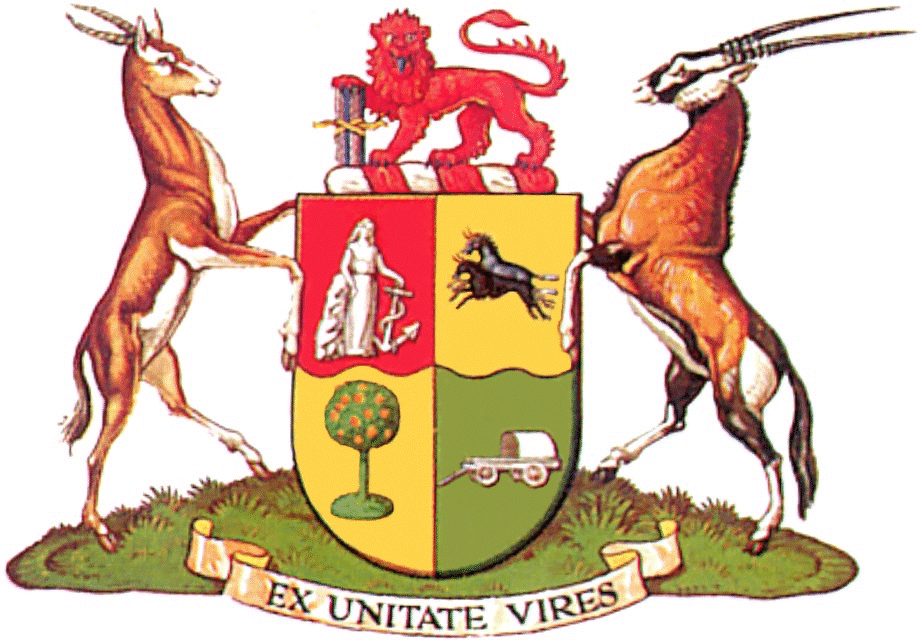
The 1910 illustration of the arms of the Union was in sole use for two decades, but fell under an increasing barrage of criticism. One newspaper correspondent remarked in 1930 that the sight of the gemsbok supporter would probably cause the death of a true gemsbok! In response, the Department of the Interior applied to the College of Arms for a replica of “the true armorial bearings” of the Union.
The new drawing, while not deviating from the blazon of 1910, was much more satisfactory. The animals were more naturally drawn, and the supporters and shield rested on a grassy compartment instead of the motto scroll. The crest no longer floated in mid-air but now rested on the shield. However, the crest was still not attached to a helmet, and the supporters’ tails were still in the “coward” position. The 1910 version of the arms continued in use in the cap badges of the South African Police and the South African Railways and Harbours, and in the sleeve rank badges of military warrant officers, but for most purposes the 1930 version took its place.
Language development:
The country’s name appears at the head of this section in English and an early official form of Afrikaans, because the 1930 drawing came into use five years after the passage of the Official Languages of the Union Act of 1925, which extended the definition of “Dutch language” in the Constitution to include Afrikaans.
The pictorial postage stamps issued in 1926 (the second definitive series of the Union) bore the country’s name in either English or Afrikaans, the Afrikaans version using the form “Suidafrika”.
Flags of the Union, citizenship and franchise:
A significant outcome of the Imperial Conference of 1926 was the Balfour Declaration, which stated inter alia that Great Britain and the Dominions were “equal in status, in no way subordinate to one another” and “united by a common allegiance to the Crown”. For South Africa, this meant that it could now have its own flag. A flag (the Union Flag) was adopted under the Union Nationality and Flags Act of 1927 which came into official use on 30 May 1928. The Union’s Blue Ensign now fell away. The Union Jack was defined as denoting “the association of the Union with the other members of the group of nations constituting the British Commonwealth of Nations”, and so was flown alongside the Union Flag – usually just on special occasions, although consistently in Natal. The Union Red Ensign (like other Red Ensigns it was known affectionately as the Red Duster) continued in use as the merchant flag.
The same Act provided for a separate South African citizenship, within the wider circle of the Commonwealth association, despite concerns in some quarters that this would be an affront to the Empire.
The first change to the franchise came in 1930, when the right to vote was extended to white women, but not to women of any other race. This undermined the already precarious position of the Coloured and black male voters of the Cape Province. This women’s suffrage was not to be exercised until the general election of 1933.
Union of South Africa
Unie van Suid-Afrika
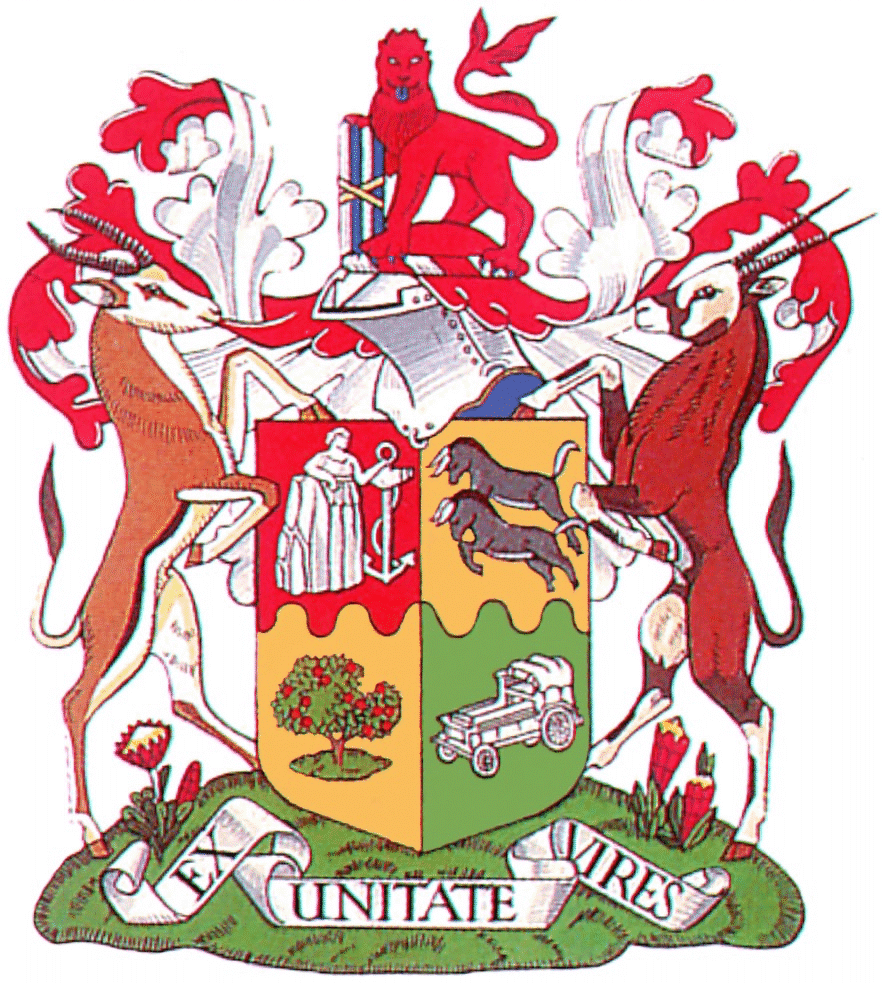
Brownell writes that the Jersey-born, London-based artist George Kruger Gray was commissioned and “produced a most attractive full achievement which was ‘recorded’ by the College of Arms on 21 September 1932 and came in to use in 1933, the same year that King George V opened South Africa House” on Trafalgar Square, London. This building, designed by Sir Herbert Baker, which housed the South African High Commission in Britain (subsequently the Embassy, and now again the High Commission), features Gray’s work in its decoration. Sir Herbert had been instrumental in commissioning the Kruger Gray drawing.
The Kruger Gray design incorporates a helmet and mantling for the first time, has the supporters’ tails high, and adds floral emblems to the compartment. However, the oxwagon is still the mistaken transport wagon of 1910 (although better drawn), rather than the trek wagon (kakebeenwa) that it ought to have been.
The flowers on the dexter side are the national flower, Protea cynaroides,[2] while those on the sinister are not clearly drawn and could be any of the Cape sugarbush (Protea repens),[3] Protea longifolia or perhaps Protea magnifica [formerly P barbigera].
The lion crest in the Kruger Gray drawing is the most mediæval of the three lions, which in one sense is most appropriate, since it takes heraldry back to its origins, but in another is rather unfortunate, since the arms of an African country reflect an animal very unlike a natural lion.
Language development:
The Afrikaans language underwent a noticeable change which attained official recognition in 1933 when a re-release of the South African pictorial stamp designs of 1926 changed the spelling of the country’s name from “Suidafrika” to “Suid-Afrika”.
Constitutional development:
This version of the arms also marks an enhanced status for South Africa. In December 1931 the British Parliament had passed the Statute of Westminster, which in effect made independent states of the British Dominions – of South Africa, Canada, Australia, New Zealand, Newfoundland (which became a province of Canada in 1949) and Éire (the Irish Free State, or Saorstát Éireann, which in 1937 became the Dominion of Éire and in 1949 left the Commonwealth on becoming a republic, the Poblacht Éireann).
This new status was formalised in South Africa in 1934 with the passage of the Status of the Union Act (transferring sovereign authority to the Union Parliament) and the Seals Act (creating a Royal Great Seal and a Royal Signet, kept in the Prime Minister’s Office and distinct from the Great Seal of the Governor-General). South Africa was the first, and for some years the only, Commonwealth member to confirm the provisions of the Statute of Westminster in its own legislation.
Even before either Parliament had passed these laws, the British Crown had made two appointments which already signified a changed status: in January 1931 a new Governor-General was appointed (on the advice of the South African Cabinet alone) who was not High Commissioner, and in April a separate appointment was made to the office of High Commissioner. This meant that the protectorates of Bechuanaland, Basutoland and Swaziland were the responsibility of an official serving in an ambassadorial capacity and representing the British Government, rather than the sovereign’s deputy as Head of State. The protectorates now set up their own postal services and issued postage stamps in 1932 (Bechuanaland, no longer using overprinted British stamps) and ’33 (Basutoland and Swaziland).
In 1937 the first South African Governor-General (a South African by domicile) was appointed, and in 1946 the first South African-born Governor-General. The last Governor-General, appointed in 1960, became the first State President of the Republic of South Africa the following year.
The first significant change to the Cape franchise came in 1936 when black voters were removed from the common voters’ roll and placed on a separate roll to elect so-called Native Representatives (who were white) to Parliament.
South Africa’s independence was demonstrated in 1939 when Britain declared war on Germany. South Africa’s status as a belligerent was not automatic, and was determined by a parliamentary vote (Parliament having been convened, coincidentally and for other purposes, the day after Britain’s declaration). General Hertzog, who wanted neutrality, was defeated, and Gen Smuts became Prime Minister.
At the end of the war, South Africa – and specifically Gen Smuts – was actively involved in the formation of the United Nations, Smuts himself writing the Preamble to the UN Charter. Gen Smuts had in this way played a key role in the foundation of three international organisations.
On 7 May 1945 the South African delegation to the United Nations expressed the opinion that the mandate over South West Africa had lapsed, and that the territory should be incorporated into the Union. The territory’s Legislative Assembly requested incorporation, and was supported by (disenfranchised) German population. An opinion survey among brown and black inhabitants produced an overwhelming majority also in favour. But at the United Nations India proposed that this proposal be turned down, and the territory was proclaimed a Trust Territory. South Africa was expected to submit annual reports, and further disputes arose over this requirement.
South Africa was thanked for its wartime contribution with an official visit in 1947 by the Head of State, King George VI, together with the Queen and their daughters the Princess Elizabeth (who was to become Queen in 1952) and the Princess Margaret. During this visit the South African Parliament was opened – the only time this happened – by the King, rather than by the Governor-General.
In 1948, Gen Smuts was removed from office with the victory of the National Party of Dr D F Malan, which planned a radical reorganisation of society, especially in that it wanted to entrench and enforce rigorously the segregation which had traditionally been part of South African life and which many now realised was outdated. Its early attempts to tamper with the franchise were defeated after voters had recourse to the courts, but after it had ensured a compliant (enlarged) Senate, the National Party succeeded in 1956 in removing Cape Coloureds from the common roll and creating Coloured Representatives in Parliament.
The parliamentary Act creating the enlarged Senate was challenged in the courts, but in affirming the Act the Appeal Court made a finding that Parliament was sovereign, and could pass any Act it wished. This was to remain a principle of South African law until 1994.
The National Party also passed the South West Africa Affairs Amendment Act in 1949, which made several changes to the administration of that territory. Significant for the Union was its provision of seats in the South African Parliament for members elected from South West Africa: six in the House of Assembly and four Senators.
Another development of 1949 was a consequence of India’s becoming a republic. Previously the King had been Head of State of all members of the Commonwealth. The Commonwealth Declaration of that year recognised the King as the symbol of the free association of the independendent member states of the Commonwealth, with the style Head of the Commonwealth.
Under South Africa’s Royal Style and Titles Act of 1953, a separate title of Queen of South Africa was created, replacing (as far as this country was concerned) the previous designation Queen of the British Dominions beyond the Seas.
In 1959 the Bantu Self-Government Act abolished Native Representatives in Parliament and envisaged the creation of self-governing states in which black South Africans would have their citizenship, losing all rights in “white” South Africa. Coming as it did after a series of moves which had angered black South Africans, it set the scene for resistance against white domination which was to have far-reaching results.
The National Party, having mooted the idea of a republic for several years, held a referendum on the question in October 1960. The outcome was significantly skewed in that Cape Coloured voters, who still had a (limited) parliamentary franchise, were excluded from voting, while South West African voters were included in the poll, even though the territory had never been incorporated into the Union. The outcome – 850 458 votes for a republic, 775 878 against – was clearly the direct result of this tampering with the franchise. Prime Minister Hendrik Frensch Verwoerd, anticipating an unfriendly reception for South Africa because of its racial policies, pre-empted any negative response from the Commonwealth by withdrawing unilaterally from that association of nations.
Flags of the Union:
In 1952 the Union Jack lost its joint status as national flag, and the Union Flag of 1928 became the sole national flag. The Red Ensign with the Union shield in the fly also fell away, and was replaced as merchant flag by the Union Flag. However in Natal, where the predominantly English-speaking white population was loyal to the British Crown, the Union Jack remained in use until 1961 as national flag (alongside the Union Flag), not only by private users but also by the Provincial Administration and municipalities (boroughs and corporations, as they were termed in Natal).
The changed status of the Governor-General also meant a change in this official’s flag, and a new flag was also brought into use for the now separate office of High Commissioner. The Governor-General’s flag was to change again (slightly) in 1953 when Queen Elizabeth authorised the use of St Edward’s crown as the symbol of the monarchy in place of the Tudor crown introduced by King Edward VII (as explained on this page).
Territorial expansion:
The creation of the Union in 1910 was not only the bringing together of four colonies, but a dream of incorporating further territory. Already in 1910 there was talk of Basutoland, Swaziland, Bechuanaland and Rhodesia. In 1918-19 sights were set not only on South West Africa, but also a scheme of Gen Smuts’s to hand 90% of German East Africa to Portugal in exchange for Mozambique south of the Zambezi. But because of Portugal’s (highly technical) status as an ally, this idea had to be dropped. As Gen Smuts had foreseen, South Africa’s not holding the port of Beira was a factor in Rhodesia’s 1924 decision to become a separate Crown Colony, instead of a province of the Union. Lastly, South Africa’s move to republican status under the NP’s racial policies was the last nail in the coffin of the idea of incorporating the three High Commission territories. All three were to take their independence in the 1960s – Basutoland (Lesotho) and Swaziland as kingdoms, and Bechuanaland as the Republic of Botswana. So South Africa ended its time as a British Dominion with exactly the same surface area and the same provinces as in 1910.
Republic of South Africa
Republiek van Suid-Afrika

Arms registered in Pretoria:
South Africa became a republic outside the Commonwealth on 31 May 1961. In 1962 Parliament passed the Heraldry Act, which created a heraldic authority comprising the Bureau of Heraldry, headed by a State Herald. The first State Herald was appointed in 1963 and had his office in the Union Buildings, Pretoria (it has since moved elsewhere in Pretoria).
The bureau registered the national arms by certificate No 152, dated 13 May 1968. The illustration follows the Kruger Gray drawing and the wording of the blazon is significantly different from that of 1910, but the arms so blazoned are still those granted in 1910 and redrawn in 1930 and ’32. The blazon reads:
Arms: Quarterly per fess wavy: I, Gules, a female figure representing Hope, resting the dexter arm upon a rock, and supporting with the sinister an anchor Argent; II, Or, two black wildebeest in full course at random, both proper; III, Or, upon an island an orange tree Vert fructed proper; IV, Vert, a trek wagon Argent.
Crest: On a wreath of the colours, a lion passant gardant Gules, supporting with the dexter paw four staves erect, alternately Argent and Azure and banded Or.
Mantling: Argent and Gules.
Supporters: Dexter a springbok and sinister an oryx (gemsbok), both proper.
Compartment: Below the shield, on a compartment grassed Vert two Proteas each with two flower heads proper.
Motto: EX UNITATE VIRES.
The wording of the blazon does not specify the colours of the crest-wreath or mantling, but in accordance with tradition, the wreath and mantling are in the same colours.
Constitution of the republic:
South Africa’s becoming a republic changed little in its Constitution. The new position of State President differed from its predecessor, Governor-General, only in that the officeholder did not represent the British sovereign. The position was still largely ceremonial, and political power was still concentrated in the Prime Minister – more so than before the 1950s, because (in terms of the Appeal Court ruling mentioned above) Parliament was now held to be sovereign. With regard to language, the Constitution now specified English and Afrikaans, rather than English and Dutch, but the equality between the two languages was unchanged, as was the entrenched nature of the language clause.
1984 Constitution:
In 1983 a majority of white voters approved a new Constitution, which was adopted in 1984, that abolished the office of Prime Minister and concentrated power in the hands of an executive State President. The sitting Prime Minister, P W Botha, was elected State President. This Constitution also abolished the Senate and the four Provincial Councils, as well as representation in Parliament for South West Africa.
It purported to give Coloured and Indian South Africans a say in the country’s affairs by creating two new Houses of Parliament, the House of Representatives (for Coloureds) and the House of Delegates (for Indians). However, since the seats allocated to these two Houses were permanently limited to 50% of the House of Assembly for the Representatives and 25% of the Assembly for the Delegates, this was clearly a farcical concession. The majority of those eligible to vote for these two Houses declined to even register, and those elected were regarded as not authentically representing the people.
Black South Africans were not brought into this reckoning, because in terms of apartheid policy they exercised their democracy through the the “independent” homeland states of Transkei, Bophuthatswana, Ciskei and Venda, as well as the six non-independent homeland states.
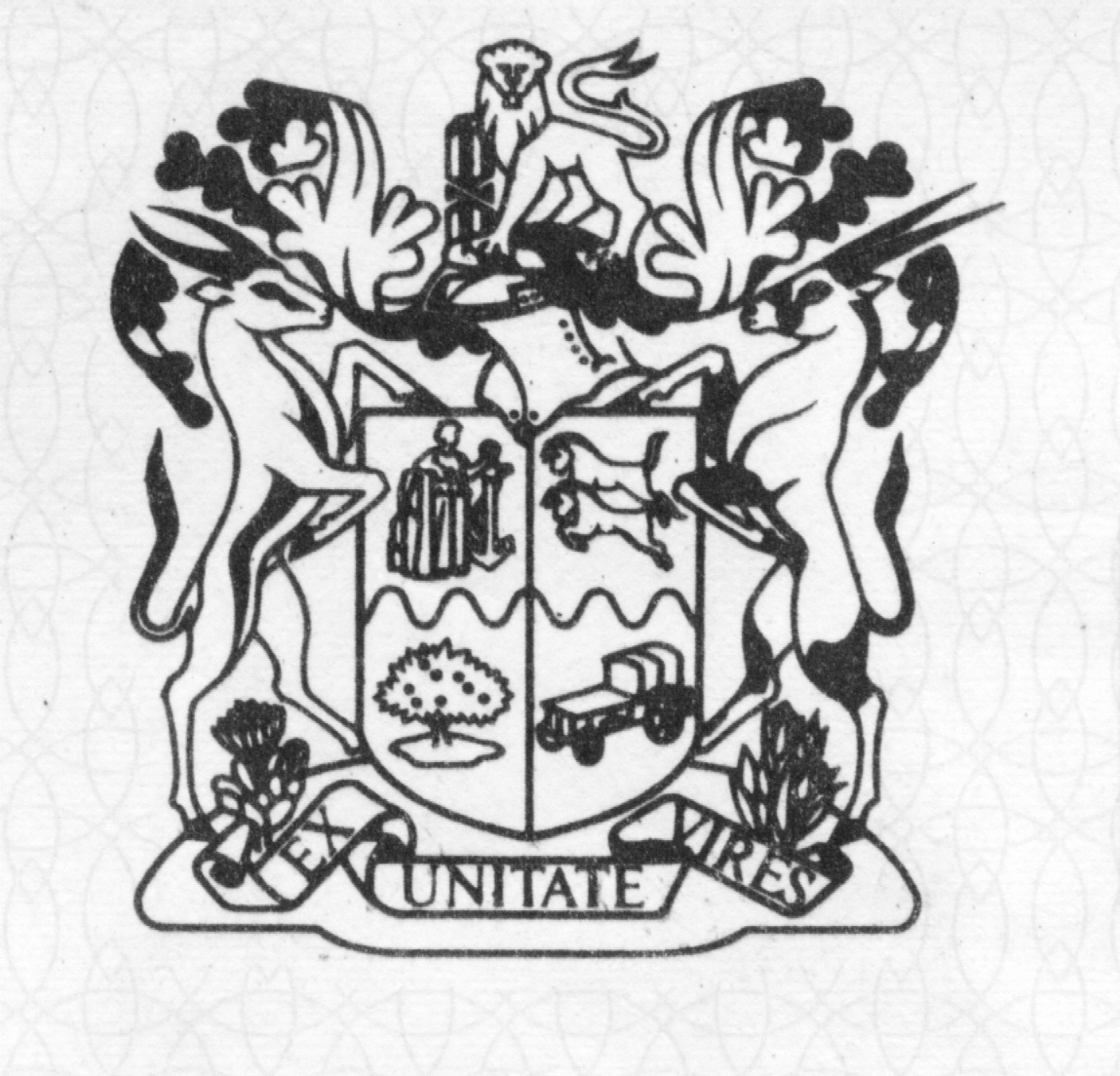
New drawing of arms:
Brownell writes: “At the request of the Office of the State President slightly simplified versions of the 1932 embellished arms were prepared by the Bureau of Heraldry in 1986, specifically for single colour printing and for gold blocking.” This version was used until the arms of 1910 were finally replaced by the new device adopted in 2000.
No new full-colour drawing of the country’s coat of arms was prepared after 1961, and the 1932 drawing continued in use until 2000.
Further changes:
Since the 1960s South Africa had experienced a low-intensity war with liberation movements in both the Republic and South West Africa (officially designated Namibia by the United Nations). During the 1970s, South African troops were sent to the north of South West Africa to contain Swapo insurgencies, and on several occasions South African forces entered Angola in support of allies in that country’s civil war. The South African Police also assisted Rhodesia’s British South Africa Police in the war there, and attempts were made to undermine Frelimo, the liberation movement in Mozambique which had assumed power upon the withdrawal of the Portuguese. The campaign within South Africa was characterised by acts of sabotage, bombings and, at a later stage, killings, while the security forces became notorious for violations of human rights.
The fall of the Soviet Union in 1990 meant that giving in to UN demands to grant Namibia independence would no longer open the border with that country to infiltration by Moscow-backed insurgents. Namibia received its independence, but within South Africa President P W Botha continued policies which were increasingly seen as harmful to the country.
Botha suffered a stroke late in 1990 which to a large extent incapacitated him, but he refused to resign. His National Party outmanoeuvred him by replacing him as party leader, which precipitated his resignation and replacement by F W de Klerk. De Klerk took action by announcing at the opening of Parliament in February 1991 that numerous restrictions introduced during the previous 30 years would be dropped, notably that the resistance movements would be unbanned and their leaders (particularly Nelson Mandela of the African National Congress) would be released from prison. Talks would be held to map out a new future for the country.
The talks eventually got under way at Kempton Park under the name of the Congress for a Democratic South Africa (Codesa), at which all South Africa’s political movements were represented. An interim Constitution was drawn up, and it was agreed that all-party elections – in which all citizens would have the vote on a non-racial basis – would be held over a number of days starting on 27 April 1994. Right-wing objections were largely neutralised by a 1993 referendum which authorised De Klerk to continue reforming. The parties also agreed that, initially, a Government of National Unity would be set up, rather than a winner-takes-all situation.
The outcome was internationally acclaimed as a miracle when four days of polling went off with barely a hitch and civil unrest virtually disappeared. Nelson Mandela was elected President (the title State President fell away) and took control of a National Defence Force in which members of the former Defence Force served on an equal basis with members of the liberation movements’ armed forces.
A new flag was taken into use on 27 April 1994, but it was agreed that the coat of arms would remain in use provisionally. It was clear that a new device was needed, since the old one represented the four colonies that had joined in 1910 and become provinces of the Union; these had been replaced on 27 April by nine provinces, of which only one had the same area as in 1910, one was slightly larger, and one had been created by joining pieces of two different former provinces.
On 27 April 2000, a new coat of arms was unveiled by President Thabo Mbeki.
[3] To see this protea (in white and pink versions), click here and go down the page. Vir Afrikaans, kliek hier Comments, queries: Mike Oettle
